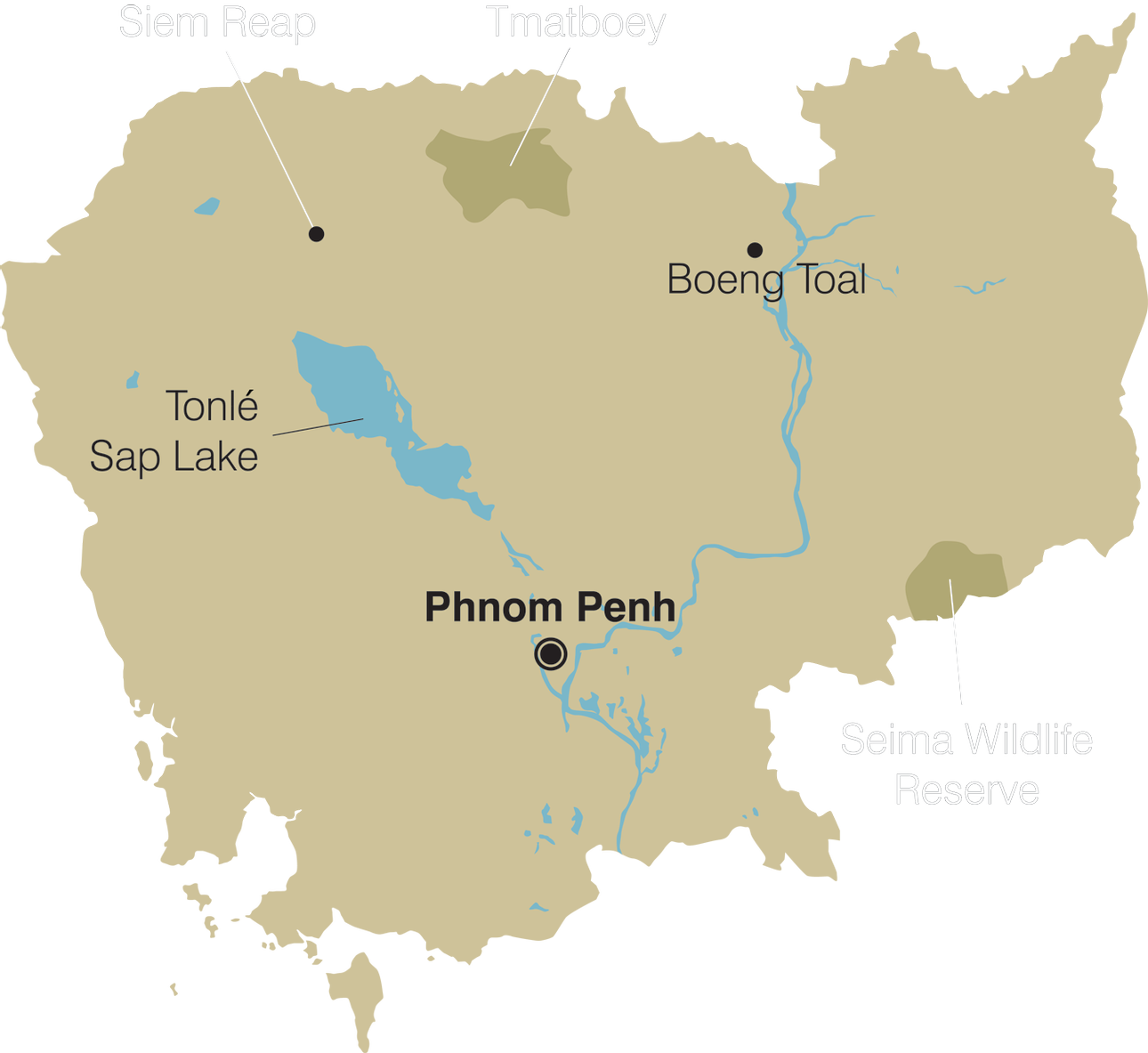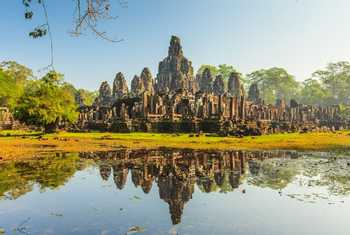


Location Highlights
- Siem Reap Area - Angkor Complex, Ang Trapeang & Prek Toal - visit the many incredible temples of the region, with the surrounding dry and wet woodlands, grassland, rice paddies - and Asia's largest freshwater lake - offering an enticingly diverse range of avifauna
- Tmatboey - home to a remarkable project to conserve the Giant Ibis and White-shouldered Ibis, with further opportunities nearby for the critically endangered Bengal Florican
- Boeng Toal Vulture Project - exciting opportunities to view the trio of endangered Asian vultures; Red-headed, White-rumped and Slender-billed
- Seima Wildlife Reserve - a wonderful combination of dipterocarp woodland, evergreen forest and bamboo, home to an internationally important population of Asian Elephant


Tailormade Holidays in Cambodia
Tailormade | Tour Code: TKHMCreate your own Tailormade holiday to Cambodia with dates and an itinerary to suit you.
When to Visit
| J | F | M | A | M | J | J | A | S | O | N | D |
| YY | YY | YY | YY | Y | Y | Y | Y | Y | Y | Y | YY |
SAMPLE HOLIDAY: Cambodia's Birds & Culture
14 days from £5,995 (Flight Inclusive)
This itinerary includes Cambodia's best birding locations whilst also incorporating the country's most iconic cultural sights.Â
Location Highlights
- Siem Reap Area - Angkor Complex, Ang Trapeang & Prek Toal - visit the many incredible temples of the region, with the surrounding dry and wet woodlands, grassland, rice paddies - and Asia's largest freshwater lake - offering an enticingly diverse range of avifauna
- Tmatboey - home to a remarkable project to conserve the Giant Ibis and White-shouldered Ibis, with further opportunities nearby for the critically endangered Bengal Florican
- Boeng Toal Vulture Project - exciting opportunities to view the trio of endangered Asian vultures; Red-headed, White-rumped and Slender-billed
- Seima Wildlife Reserve - a wonderful combination of dipterocarp woodland, evergreen forest and bamboo, home to an internationally important population of Asian Elephant


Quick Enquiry
Summary
The world-renowned Angkor temple complex is a UNESCO World Heritage Site of soaring architectural marvels and is understandably many people’s sole reason to visit Cambodia. However, for the wildlife enthusiast, the country also offers a wealth of possibilities, and supports a mind-boggling array of species including over 530 species of birds, many endemic, and others which are almost lost to the rest of south-east Asia.Â
Cambodia is nestled in tropical south-east Asia between Laos, Thailand and Vietnam and hosts abundant wildlife treasures. There is a wonderful mix of habitats, including dry forests, evergreen forests, open grasslands, wetlands and the mighty Mekong River, the latter home to rare Irrawaddy Dolphins and the recently discovered Mekong Wagtail.
The number of rare and endangered species found in Cambodia, such as Giant and White-shouldered Ibis which are almost impossible to see elsewhere, will surprise and delight visitors to this fascinating country. Other star species present in encouraging numbers include Bengal Florican, Milky Stork and the trio of endangered Asian vultures – Red-headed, White-rumped and Slender-billed. Some impressive conservation projects are also underway in the country, many of which are predominantly funded by eco-tourism.
No trip to Cambodia would be complete without a visit to Angkor Wat, an excellent birdwatching site in its own right. But this is merely a jewel in an opulent crown, for Cambodia boasts many fabulous temples, statues and other historical marvels, many of which will be explored during a wildlife holiday.
Our Destinations

The most famous part of Cambodia is the Siem Reap area, which includes Angkor Wat itself. However, many people don’t realise that just to the north of the temple complex is south-east Asia’s largest freshwater lake. The flooded woodland of Prek Toal hosts one of the most important colonies of waterbirds in south-east Asia, with 100,000 pairs of storks, herons, egrets, ibises and pelicans, including rarities such as Spot-billed Pelican and Milky Stork. A boat trip here offers the opportunity to get close to the birds and is perfect for photography. Not far away is Ang Trapeang Thmor, a complex of wet grassland and rice paddies where the fast-declining Sarus Crane, the tallest bird in Asia, breeds, along with a host of other exciting birds and the critically endangered Eld’s Deer. Angkor Wat itself is also set within an area of disturbed dry forest with permanent watercourses (‘barays’ or moats) and is surprisingly good for birding. Arriving at Angkor Wat for first light to enjoy the temples and birds in the morning air is an experience not easily forgotten. Forest Wagtail and Hainan Blue Flycatcher are just two of the avian delights one might encounter here. Not far away, the Bayon Temple in Angkor Thom, the last capital city of the Angkor Empire, is also profoundly impressive, as is the delightful Ta Prohm Temple nestled amidst tangled tree roots. All these places are easily accessible in a relatively small area, with comfortable hotel accommodation in Siem Reap itself.

The village of Tmatboey is on Cambodia’s northern plains and basks in a rich ecosystem encompassing seasonal grasslands, open woodland and deciduous dipterocarp woodland (the signature forests of the region). This extraordinary area is home to a remarkable conservation project aimed at helping two great rarities, the Giant Ibis and the White-shouldered Ibis. We stay at the community eco-lodge established by the Ministry of Environment, a unique project aimed at linking wildlife tourism, conservation and development. Nearby, the natural grasslands provide habitat for the critically endangered Bengal Florican.

Cambodia is one of the few countries with stable populations of Asia’s three critically endangered vultures; the Red-headed, White-rumped and Slender-billed. The premier cause of the decline, a drug that was administered to sick cattle but which kills vultures, has never been used here. To keep the birds from straying to other countries, the Wildlife Conservation Society has set up ‘vulture restaurants’ for supplementary feeding and research, and the one at Boeng Toal may attract 60-70 birds at dawn, as well as Golden Jackals, Dholes and Greater Adjutant Storks. The carcass is funded by visitors, thereby contributing to the local economy. Accommodation is in a nearby camp.

This reserve lies in the Eastern Plains, the largest intact block of forest in the whole of south-east Asia; a wonderful mixture of dipterocarp woodland, evergreen forest and bamboo. The biodiversity here is incredible, with more than 300 bird species recorded, and nearly 100 mammals. Among the latter, the reserve plays host to an internationally important population of Asian Elephants; although, despite their size, it can take quite an effort to see them. There are also some wonderful primates, including the rare Black-shanked Douc Langur and Southern Buff-cheeked Gibbon. Birds abound here, and the reserve hosts one of the highest concentrations of woodpeckers in the world, with 16 species recorded including Great Slaty (the largest of all woodpeckers), White-bellied and Heart-spotted. Other birds of note include Germain’s Peacock Pheasant, Green Peafowl, Siamese Fireback, Great Hornbill, Orange-necked Partridge and the stunning Bar-bellied Pitta. This is one of the last remaining wilderness areas in the country.
Sample Itineraries
This itinerary includes Cambodia's best birding locations whilst also incorporating the country's most iconic cultural sights.Â

Experience the diverse array of birdlife across these two spectacular neighbouring countries, whilst also marvelling at the magnificent temples at Angkor

The Essentials
- Wildlife Guides: An excellent, English-speaking local naturalist guide will accompany you throughout your holiday in Cambodia. Our guides are also all certified temple guides, so their knowledge extends to all aspects of Cambodia’s heritage.
- When to Visit: Cambodia can be a rewarding destination at any time of the year, particularly the Siem Reap area – which includes Angkor Wat – and Seima Wildlife Reserve. However, the best time for viewing wildlife is undoubtedly the cooler and drier months between December and March, when many of the birds are singing and the trees have lost their leaves, making sightings easier. April to August is the wet season, when some wetland sites are flooded, and March to July is hot and humid. At Tonle Sap the water levels are highest in October, with the birds breeding from November to May. The Giant Ibis is present at Tmatboey from January to April, with the White-shouldered Ibis present all year. The vulture feeding station operates all year round.
J F M A M J J A S O N D YY YY YY YY Y Y Y Y Y Y Y YY - Getting Around: Navigating the road network in Cambodia has long been an adventure, but vast improvements have been made in recent times, with many repairs and upgrades to highways throughout the country. The best wildlife sites typically require travelling on bumpy roads, and during the wet season these can frequently be impassable. One of the delights in moving around cities is the use of ‘tuk-tuks’, which are everywhere.
Why Naturetrek Tailormade?
'A Naturetrek Tailormade holiday allows you, with the benefit of our wildlife travel expertise and destination experience, to enjoy the perfect private wildlife holiday – one that truly matches your requirements, expectations and ambitions. We will ensure the most competitive prices, superb naturalist guides and seamless ground services.
Some of the benefits of Naturetrek Tailormade travel include:
• A bespoke itinerary which is crafted by experts and designed specifically for you
• Private guiding by the very best local naturalistsÂ
• Travel with people you know, at your own pace
• Incorporate as much culture, history or relaxation time as you wish
• Choose dates to suit you
• Select your preferred style of accommodation
• Travel with families and children of any age
Furthermore, our Tailormade team are always on hand to help and guide you along the way, with friendly advice, first-hand knowledge and inside information specific to your destination of choice. So if you have any queries about your holiday, we will be delighted to answer them. Please just give us a call!'

Similar Trips
Tailormade Holidays in Bhutan TAILORMADE | TOUR CODE : TBTN
- Jan
- Feb
- Mar
- Apr
- May
- Jun
- Jul
- Aug
- Sep
- Oct
- Nov
- Dec
Tailormade Holidays in Borneo TAILORMADE | TOUR CODE : TMYS
- Jan
- Feb
- Mar
- Apr
- May
- Jun
- Jul
- Aug
- Sep
- Oct
- Nov
- Dec
Tailormade Holidays in Vietnam TAILORMADE | TOUR CODE : TVNM
- Jan
- Feb
- Mar
- Apr
- May
- Jun
- Jul
- Aug
- Sep
- Oct
- Nov
- Dec



 Loading search...
Loading search...



































